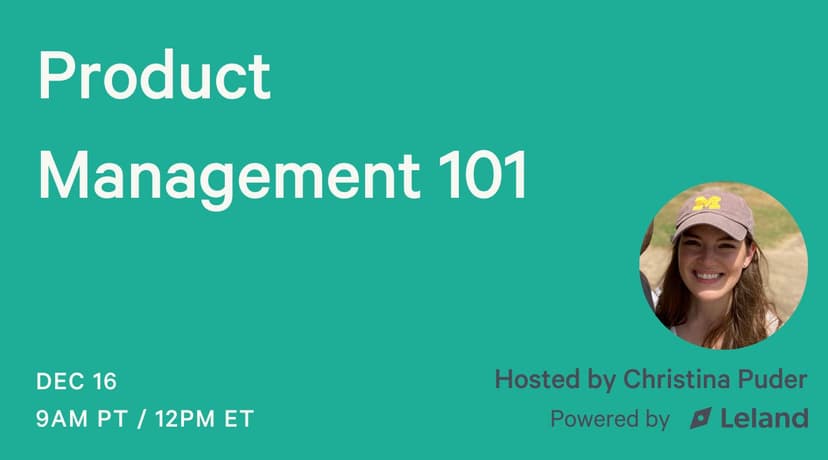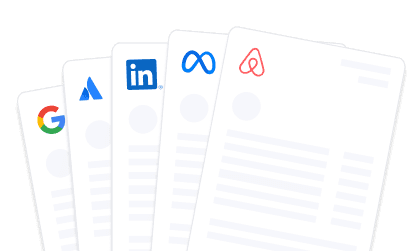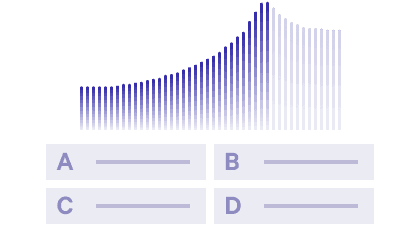DoorDash Product Manager Interview: Process, Questions, & Tips (2025)
Get expert strategies, real questions, and a step-by-step prep plan for the DoorDash product manager interview, built to help you stand out and succeed.
Posted September 12, 2025

Join a free event
Learn from top coaches and industry experts in live, interactive sessions you can join for free.
Table of Contents
Preparing for the DoorDash Product Manager interview can feel daunting, but with the right prep and insider strategies, you can stand out and land the role. This guide breaks down the interview process, shares real questions from past candidates, and walks through expert-backed tips to tackle even the trickiest rounds.
We’ve analyzed top competitor guides, real-world Reddit insights, and actual PM interview experiences to create a comprehensive, human-first resource for candidates.
Read: The Different Types of Product Management: An Overview of Specialist PM Jobs
What to Expect from the DoorDash PM Interview Process
The DoorDash PM interview process typically includes 4–6 stages. While your exact experience may vary based on your current position, product manager level, or team, here’s the general interview rounds structure:
| Stage | What It Covers | Sample Questions | Expert Tips | Reddit / Insider Insight |
|---|---|---|---|---|
| 1. Recruiter Screen | This stage evaluates your resume fit, alignment with the DoorDash product manager role, and overall career trajectory. | Interviewers may ask, “Walk me through your background” or “Why are you interested in DoorDash?” | Prepare a concise 2–3 minute narrative that highlights your product management journey, key outcomes, and career transitions. Speak specifically about why DoorDash’s mission or product suite excites you. | Candidates report that recruiters are looking for clarity and confidence. Avoid rambling and make sure your timeline is clean and easy to follow. |
| 2. Phone Screen with Hiring Manager or PM | This round focuses on high-level product sense, leadership capability, and your fit with the team. | Common questions include, “Tell me about a time you launched a product,” or “How would you improve DoorDash’s post booking experience?” | Structure your answers using CIRCLES or SPADES, but keep it natural. Emphasize your ability to define problems, prioritize trade-offs, and measure success. Make sure to tie everything back to user needs and business outcomes. | Many candidates are caught off guard by the ambiguity in questions. Interviewers want to see whether you slow down to ask clarifying questions before jumping in. |
| 3. Take-Home Assessment (for select roles) | You may receive a dataset involving orders, restaurants, or drivers and be asked to analyze it to inform product decisions. | A typical prompt might ask you to identify key metrics and recommend a product improvement based on operational data. | Begin by stating your assumptions and acknowledging any gaps in the dataset. Focus your analysis on business goals, user impact, and actionable next steps. Use clear, visual communication if possible. | Reddit users frequently mention that the datasets are incomplete or messy. What matters most is showing structured thinking and transparency around limitations. |
| 4. On-Site Interviews (often virtual) | You will go through multiple rounds testing your product sense, product strategy, execution, analytics skills, and behavioral fit. Each round is usually led by a different interviewer. | You might be asked to design a new feature for DashPass, recommend a market strategy for new verticals, interpret a drop in merchant metrics, or describe how you handled team conflict. | Use product frameworks flexibly to guide your thinking, but adapt based on the problem. For execution rounds, focus on selecting and interpreting the right metrics. For behavioral questions, come prepared with well-structured stories that highlight leadership, decision-making, and communication. | Several candidates note that behavioral rounds can feel rushed or interrupted. It is essential to have tight, high-quality stories ready that demonstrate key competencies even under time pressure. |
| 5. Final Round or Executive Loop | This stage is designed to assess your strategic thinking, communication skills under pressure, and alignment with DoorDash’s long-term goals. | You may be asked to share your long-term product vision, present a roadmap proposal, or discuss how you’d handle trade-offs in resource allocation. | Think big-picture and speak with clarity. Tie your answers to company-wide business objectives and user impact. Show that you can think like an owner and operate at an executive level. Use this round to demonstrate leadership presence and initiative. | Candidates sometimes face follow-up questions about earlier rounds. Be prepared to revisit previous answers, reflect on feedback, and clarify anything that may have been unclear earlier in the process. |
Read: The Ultimate Product Manager Interview Guide
Common DoorDash PM Interview Questions (and How to Master Them)
Below are real interview questions you’re likely to encounter during the DoorDash PM interview process, along with expert-driven guidance on how to approach each one with clarity, depth, and impact.
Product Sense: “How would you improve the post booking experience on DoorDash?”
This question is testing your user empathy, structured thinking, and prioritization skills. Interviewers want to see how you dissect the user journey, identify pain points, and propose high-impact improvements.
How to answer: Start by reframing the problem in your own words to demonstrate a clear understanding of what the “post booking experience” entails, from order confirmation to delivery and feedback. Walk through the full user journey and highlight 2–3 key friction points (e.g., inconsistent ETAs, lack of delivery updates, poor driver communication). Use a lightweight framework like CIRCLES or Problem → User → Ideation → Prioritization → Define Success. End by identifying metrics you’d use to track success (e.g., CSAT, NPS, order cancellation rate) and briefly mention trade-offs (e.g., operational complexity vs. user delight).
What top candidates do: They show real insight into what the user feels at each step. They don’t just throw ideas out; they walk the interviewer through their logic and show how they’d validate those ideas through data.
Strong example answer:
“Let me start by defining the post booking experience as everything that happens between placing the order and receiving the food. The goal is to reduce friction, increase trust, and ultimately improve user satisfaction during that phase.
I’d break the journey into four stages: order confirmation, preparation, delivery tracking, and receipt. I’d first identify pain points in each. For example, unclear prep times, inaccurate ETAs, or a lack of live driver updates.
Based on that, one improvement could be a real-time ‘Order Confidence Score’ that dynamically updates based on prep speed, Dasher availability, and traffic. Another could be a richer delivery tracking UI, with proactive notifications for delays.
To prioritize, I’d score ideas based on impact, effort, and alignment with DoorDash’s business objectives, like reducing cancellations and support tickets.
I’d define success using a few key metrics: reduction in order-related CS tickets, increase in post-order NPS, and improved delivery time predictability. I’d also run experiments to test these against control experiences.”
Product Strategy: “How should DoorDash expand into a new vertical (e.g., groceries)?”
This question assesses your ability to think strategically and make decisions that align with business objectives. It’s less about launching features and more about understanding markets, operations, and risk.
How to answer: Clarify the goal—are we expanding to drive growth, retention, or profitability? Lay out a structured approach: analyze market size, frequency of use, competitive landscape, and operational fit with DoorDash’s core capabilities. Highlight trade-offs (e.g., perishability of groceries vs. ease of delivery for convenience items) and how they impact merchants and Dashers. Suggest a pilot market, explain why it’s a good starting point, and describe how you’d measure early success.
What top candidates do: They ground their answer in business thinking—unit economics, user needs, operational feasibility—and show a real understanding of DoorDash’s ecosystem (including merchants and drivers, not just users).
Strong example answer:
“Before recommending a specific vertical, I’d clarify the objective. Are we optimizing for user growth, market expansion, revenue per order, or merchant partnerships?
Assuming we want to increase customer LTV through frequent-use categories, groceries are promising due to high order frequency and margin potential. I’d assess internal capabilities (e.g., delivery logistics, cold storage, batch delivery routing) and external competition from Instacart, Amazon, etc.
I’d prioritize cities where DoorDash has strong driver density and merchant relationships to pilot. The go-to-market plan would include limited SKUs, a fast delivery promise, and merchant-managed fulfillment.
I’d define success through metrics like repeat grocery orders per user, substitution rate, average order value, and incremental LTV. I’d also watch operational efficiency metrics to flag fulfillment bottlenecks.”
Analytics & Metrics: “Your feature led to a drop in restaurant NPS. What do you do?”
This tests your product judgment, data literacy, and bias for action under uncertainty. DoorDash expects PMs to move fast, but not blindly.
How to answer: Begin by asking clarifying questions: What’s the timeframe? What changed in parallel? Which restaurants were affected? Segment the data and look at correlated metrics (e.g., order accuracy, delivery time). Identify 1–2 plausible causes and propose a plan to investigate further, whether that’s through data analysis, user research, or A/B testing. Suggest next steps, including whether to roll back, iterate, or communicate proactively with stakeholders.
What top candidates do: They don’t panic. They show a thoughtful, data-informed approach and communicate trade-offs clearly (e.g., improving one metric may temporarily hurt another).
Strong example answer:
“First, I’d confirm whether the drop is statistically significant and isolate which segment of restaurants was affected by size, region, or feature usage. I’d ask for data over time, broken down by adoption rate and feature exposure.
I’d also look at secondary metrics like order volume, prep time, cancellation rate, or onboarding issues, to triangulate the root cause.
Based on this, I’d form a few hypotheses. For example, maybe the feature adds steps to the order flow that delay fulfillment, or it shifted volume to certain restaurants unevenly.
I’d design a rapid test or survey to validate the most likely causes and explore short-term mitigations, like opt-outs or default configurations.
Long-term, I’d work with Design and Ops to adjust the feature, update training, and improve messaging. Throughout, I’d communicate with stakeholders to keep expectations grounded and solutions transparent.”
Behavioral Fit: “Tell me about a time you disagreed with an engineer.”
This question is about collaboration under pressure. DoorDash PMs work cross-functionally every day, often with competing priorities and limited resources.
How to answer:
Use a focused STAR story. Set the stage with context (e.g., a roadmap debate or technical feasibility constraint). Explain the core of the disagreement and how you approached it—with empathy, curiosity, and clarity. Highlight how you aligned around shared goals, how the conversation evolved, and what the outcome was. Most importantly, share what you learned and how the experience made you a better teammate or decision-maker.
What top candidates do: They don’t gloss over the tension. They show maturity, adaptability, and a strong understanding of when to push and when to listen.
Strong example answer:
“At my last company, we were building a feature to improve restaurant onboarding. I wanted to include a real-time verification step to reduce onboarding errors, but the engineering lead pushed back, saying it would add two sprints of complexity.
I paused to understand his perspective better. We were under tight timelines, and he was right about the complexity. I proposed a compromise: instead of real-time validation, we’d batch verify accounts every hour and surface errors asynchronously.
This reduced the tech burden while preserving the core value of cleaner onboarding. We ended up launching on time, and error rates dropped by 20%.
What I learned was that disagreement often signals a gap in priorities or context. When you lead with curiosity instead of conviction, you find better paths forward.”
Read: The 10 Most Common Product Management (PM) Behavioral Interview Questions
How to Prepare: 5-Step Plan
Here’s a tactical prep flow we recommend:
Master the Interview Structure Before You Start Practicing
Start by deeply understanding the full DoorDash PM interview process: what each round is testing, how long they typically last, what types of interviewers you’ll encounter, and how the process may shift depending on role level or team (consumer, logistics, merchant, etc.). This context will shape your prep strategy and help you avoid blind spots. Don’t treat it like a mystery; deconstruct it like a product flow.
Build a Strategic Story Bank, Not Just STAR Examples
You’ll need 5 to 7 strong, flexible stories that cover high-leverage themes: leadership without authority, tough prioritization calls, cross-functional conflict, failure and recovery, and metrics-driven wins. But don’t just plug them into a rigid STAR format. Think of your stories like reusable components. You should be able to flex them across different behavioral prompts and tailor the setup, actions, or outcomes based on the question. If you can’t tell a clear, impact-first story in under two minutes, it’s not interview-ready yet.
Simulate the Real Interview At Least Three Times
Reading sample questions won’t cut it. You need to practice live, under time pressure, with structured feedback. Aim to complete at least three mock interviews that cover the core categories: product strategy, execution/analytics, and behavioral leadership. Ideally, practice with someone who’s worked at DoorDash or another top-tier tech company. Someone who can push your thinking, interrupt when needed, and call out fuzzy logic or over-rehearsed language. Simulation is what turns knowledge into fluency.
Train on Real Questions, Not Just Frameworks
The DoorDash PM interview has specific patterns, metrics questions tied to Dasher or merchant experience, ambiguous product design prompts with real-world constraints, and behavioral questions that expect depth, not fluff. Don’t just prepare “PM interview questions.” Prepare DoorDash PM interview questions based on what’s actually being asked (Glassdoor, Exponent, Reddit, Leland coaches). Review recent patterns, rehearse case types like post-booking experience improvements, restaurant-side NPS challenges, and trade-offs in new verticals like grocery. Then layer your frameworks only when they help structure your thinking, not as a script.
Study DoorDash Like a PM, Not a Candidate
Go beyond headlines. Analyze DoorDash’s product ecosystem, merchant operations, Dasher incentives, user segmentation, and recent strategic moves. Understand how they’re positioned relative to Uber Eats, Grubhub, and Instacart. Map out their key challenges (e.g., operational scalability, multi-vertical expansion, merchant churn), and prep examples that show you’ve thought through how your role could impact those business objectives. The best candidates sound like they’ve already been thinking about DoorDash’s business for months, not just the night before.
Read: Product Manager Interview Prep: Top Resources & Tips
If you want structured, role-specific feedback, you can work with a top PM coach who’s been on both sides of the table. They’ll help you refine your answers, pressure-test your stories, and build confidence across every round of the process. Browse PM coaches here.
Real World Insights: What Caught People Off Guard
Reddit threads and real candidate debriefs reveal several under-the-radar challenges that often catch candidates off guard in the DoorDash PM interview process.
First, ambiguity is intentionally built into many questions, particularly in product sense and strategy rounds, to test how you navigate uncertainty. Candidates who fail to ask clarifying questions or explicitly state assumptions often stumble early.
Second, take-home assessments can be surprisingly difficult; they're often based on messy, incomplete data sets that require thoughtful assumptions and a clear path to actionable insights. Rather than obsessing over perfect analysis, focus on telling a clear story that aligns with business objectives and customer impact.
Third, behavioral interviews are frequently fast-paced, loosely structured, or even interrupted, requiring candidates to deliver concise, outcome-first stories with adaptable structure.
Finally, over-preparing is a genuine differentiator. Top performers consistently report that doing timed mock interviews, rehearsing frameworks like CIRCLES or AARM, and refining their behavioral stories gave them a significant edge. Reading guides isn’t enough as success comes from live practice, pressure-tested thinking, and structured self-reflection.
Want to go beyond self-study? Work with Olivia M., a former PM and seasoned interviewer who’s helped hundreds of candidates land roles at top tech companies. Olivia specializes in helping you structure answers, refine your product sense, and run realistic mock interviews that mirror the toughest parts of the DoorDash process.
Frameworks & Tools to Bring Into Your Interviews
Frameworks are only helpful if used flexibly. Here are a few to guide your thinking:
| Area | Framework | What It Helps You Do | When to Use It | Expert Tips |
|---|---|---|---|---|
| Product Sense | CIRCLES, SPADE | Break down product design questions by understanding users, defining problems, and generating thoughtful solutions. | Use when asked to improve a feature (e.g., post booking experience) or design something new. | Don’t run through the steps robotically. Use the structure to slow down, clarify goals, and explore user pain points deeply. Tailor the depth based on time and interviewer prompts. |
| Metrics & Success Definition | AARM, HEART | Define the right metrics for success, track user behavior, and align on business goals. | Use in execution rounds or when asked “How would you measure success?” or “What metrics would you track?” | Anchor metrics to the user journey and the product’s objective. Don’t stop at just naming metrics. Explain why they matter and what trade-offs you’d consider (e.g., leading vs. lagging indicators). |
| Product Strategy & Vision | SWOT, Three Horizons | Evaluate market and product opportunities based on strengths, weaknesses, risks, and long-term positioning. | Use in strategic roadmap or “how should DoorDash expand into X” type questions. | Bring in real-world context (e.g., DoorDash’s logistics strengths, competition from Instacart/Uber Eats). For Three Horizons, distinguish clearly between short-term improvements vs. long-term innovation bets. |
| Prioritization & Trade-Offs | RICE, Impact/Effort Matrix | Make tough calls on feature prioritization, roadmap trade-offs, or MVP planning. | Use when asked “What would you build first?” or “How would you prioritize these 3 features?” | Explain how you’d size Reach and Impact, don’t just throw numbers around. Clarify assumptions behind each input. For time-pressured interviews, use the Impact/Effort grid to quickly convey prioritization logic. |
Bonus Advice: Great candidates don’t name-drop frameworks; they use them to organize their thinking in real-time. If you're asked a question that seems ambiguous or broad, it's completely fine to pause, choose a mental model, and say: “I’ll approach this using a simple prioritization framework to compare impact and effort. First, let me define the key options and then walk through each briefly...”
DoorDash Product Manager Role: Expectations and Compensation
The DoorDash product manager role is not a one-size-fits-all position. It varies meaningfully depending on the team you join (Consumer, Merchant, Dasher, Platform, Growth, etc.). However, across all teams, the expectations are consistently high. DoorDash PMs are expected to operate as mini-GMs: owning the roadmap end-to-end, leading cross-functional initiatives, and delivering tangible business impact at speed.
You’ll be responsible for setting the product vision, defining strategy, and driving execution, often in ambiguous problem spaces with limited precedent. Success in the role hinges on your ability to connect customer needs to measurable outcomes, align stakeholders across engineering, design, operations, and analytics, and make high-quality decisions quickly, often with incomplete data.
This is not a role where PMs hand off specs and track progress. You are expected to deeply understand the product surface area, dive into metrics, work through technical constraints with engineers, and anticipate downstream operational challenges. Especially at a company like DoorDash, where the product is the business, PMs are held to an exceptionally high bar in terms of strategic thinking, speed, and ownership mentality.
Top-performing PMs at DoorDash don’t just launch features; they drive market-moving initiatives. Think: optimizing the restaurant onboarding funnel to reduce churn, reworking Dasher incentives to balance supply, or expanding into new verticals like convenience or groceries while maintaining core delivery speed. These initiatives require not just product intuition, but operational awareness, cross-functional influence, and strong decision-making under pressure.
DoorDash offers competitive compensation packages that reflect both the intensity of the role and the expectations of impact.
- Base salary typically ranges from $155,000 to $185,000, depending on level, team, and experience.
- Total compensation, which includes annual performance bonus and equity (RSUs), generally falls between $220,000 and $280,000, though senior or specialized roles (like PMs leading strategic growth or platform teams) may exceed this range, especially in high-cost markets like San Francisco or New York.
Keep in mind that RSU refreshes and performance bonuses are tied closely to execution quality and measurable outcomes, not just tenure or effort. PMs who outperform tend to see rapid leveling and significant upside through equity growth.
If you’re targeting this role, it’s worth not only preparing for the interview but also calibrating your expectations around what success looks like once you’re in the seat. DoorDash rewards impact, speed, and ownership at every level.
Final Tips + What Not to Forget
- Always define what success looks like in your answers. Don’t just propose solutions, anchor them in measurable outcomes tied to key metrics, business goals, and customer value. The strongest candidates clearly articulate, “Here’s how I’d define success for this initiative…”
- Ground every answer in your real experience. Interviewers can spot theoretical fluff instantly. Use concise, outcome-first examples from your past roles that demonstrate ownership, results, and product intuition. Your stories should feel specific, high-stakes, and hard-earned.
- Lean into trade-offs and ambiguity, don’t avoid them. DoorDash wants PMs who can operate in gray areas. When a question is vague, clarify the scope, state assumptions, and explain the factors you'd weigh. Showing how you think through complexity is more important than getting to a “right” answer.
- Expect curveball questions, and be ready to reason under pressure. DoorDash PM interviews often include creative, unscoped prompts designed to test your ability to think clearly and communicate structure in real-time. Practice questions like:
- “You manage six pizza shops. How would you improve delivery efficiency?”
- “Redesign the Apple App Store experience for food delivery apps.”
- “How would you fix the worst customer experience you've ever had on DoorDash?”
- Think like a general manager, not just a product builder. Your answers should reflect awareness of customer needs, business strategy, operational complexity, and engineering trade-offs, not just surface-level product ideas.
- Don’t try to impress, try to be useful. The best candidates sound like people you'd want on the team tomorrow: thoughtful, clear, decisive, and focused on impact over jargon.
Final Thoughts: How to Win the DoorDash PM Interview
Landing a product role at DoorDash isn’t just about being smart; it’s about showing that you can think like a high-impact PM in a fast-moving, operations-heavy business. That means navigating ambiguity with structure, grounding decisions in real metrics and trade-offs, and demonstrating that you understand how DoorDash’s products, customers, merchants, and drivers all connect.
The best candidates come in sounding like they already belong. They don’t just answer questions—they lead conversations, communicate clearly under pressure, and show a sharp understanding of both the customer journey and business levers that drive outcomes.
If you’re serious about breaking in, don’t wing it. Work with a coach who can help you tighten your stories, sharpen your answers, and pressure-test your thinking before the real thing. On Leland, you’ll find top PM coaches, including former DoorDash interviewers, who can run realistic mocks, give structured feedback, and help you walk into your interview with clarity and confidence.
Browse top PM interview coaches here and get the support that turns preparation into an offer. Also, check out free events to learn more about PM strategies.
Read these next:
- Netflix Product Manager Interview: Process, Questions, & Tips
- Apple Product Manager Interview: Process, Questions, & Tips
- TikTok Product Manager Interview: Process, Questions, & Tips
- PayPal Product Manager Interview: Process, Questions, & Tips
- Product Design Interview: What It Is, Questions, & Tips
- Product Sense Interview: What It Is, Questions, & Tips
- Product Execution Interview: What It Is, Questions, & Tips
- AI Product Manager Interviews: Questions & Tips
FAQs
How long is the DoorDash PM interview process?
- It typically takes 2–4 weeks from recruiter screen to offer, depending on availability and role seniority.
Is the take-home case required for all candidates?
- No, but it's common for consumer PM roles. You'll analyze a dataset and make product recommendations.
What types of interview questions are most common?
- Expect a mix of product sense, product strategy, behavioral questions, and data/metrics interpretation.
What are the biggest pitfalls candidates face?
- Not asking clarifying questions, vague answers, and failing to tie ideas back to users and metrics.
How can I stand out?
- Bring strong product thinking, customer obsession, and show you understand DoorDash’s business and constraints.
Browse hundreds of expert coaches
Leland coaches have helped thousands of people achieve their goals. A dedicated mentor can make all the difference.

























